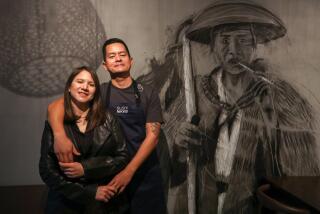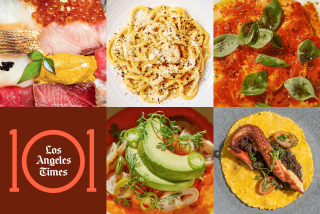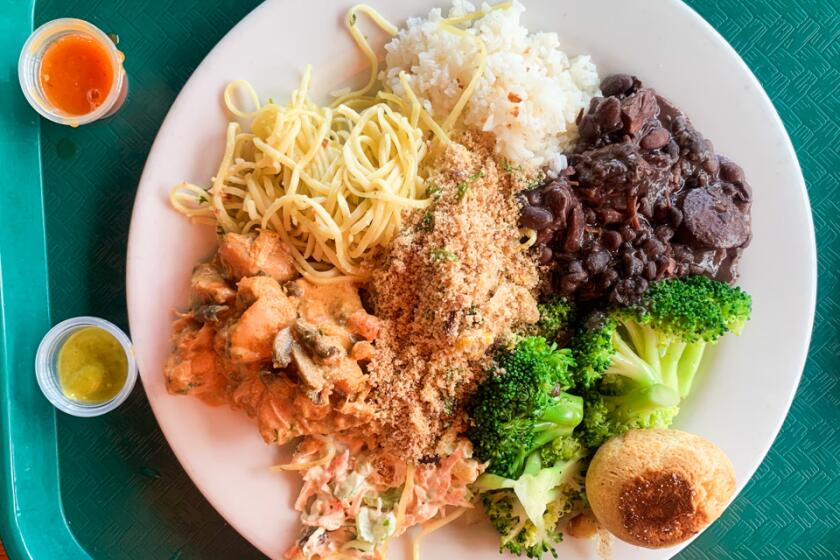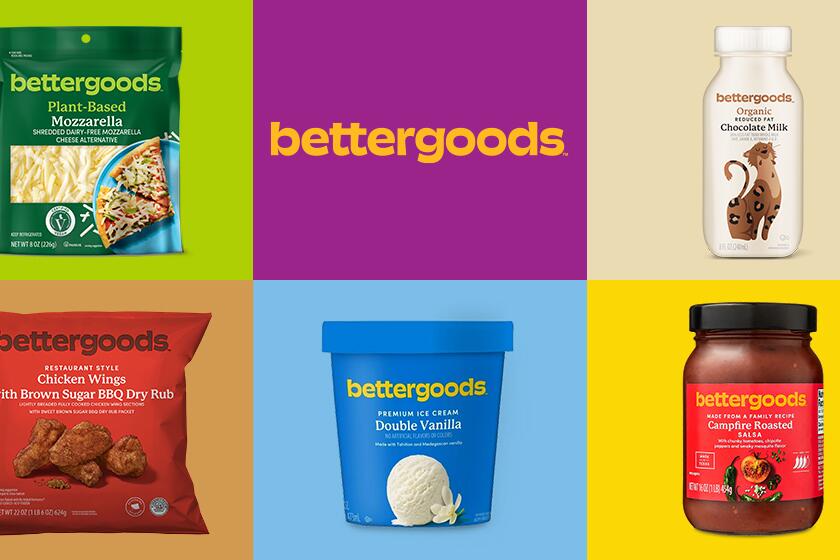Your personal sommelier, on a $300 spree
IT’S a great time to buy wine.
Thanks to a glut of wines on the global market, even producers of the most sought-after California wines have dropped their prices. Recent vintages in France have ranged from swell to fabulous, making it possible to pick up wonderful bottles without experiencing sticker shock. And efforts by winemakers from Argentina to New Zealand to bring the fruits of their labors to thirsty Los Angeles, one of the world’s premier wine markets, mean that the Southland is awash in exciting, undiscovered -- often inexpensive -- wines.
The moment has arrived to start putting together that cellar you’ve always talked about -- or to brighten up an existing collection with some terrific buys.
But with all that wine out there, how to separate the nectar from the plonk?
No one is savvier about buying wine than a good sommelier, whose professional mission it is to find great values at all price levels. Seeking guidance, we asked four of L.A.’s top sommeliers -- among the best wine buyers in the city -- for the inside dope. We asked them to tell us what they would buy, given $300, on a wine shopping spree, ferreting out great values from local wine shops at bargain prices.
Our experts are all associated with restaurants that feature forward-looking wine programs; their wine lists each have a particular slant, reflecting each establishment’s personality. Patti Rockenwagner, wine buyer at Rockenwagner in Santa Monica, has a penchant for German and Austrian wines, while Christophe Rolland, sommelier at Bastide in Los Angeles, favors those from France. Bonnie Graves, sommelier at Spago Beverly Hills, and David Rosoff, owner and sommelier at Opaline in the Fairfax district, both have wide-ranging wine lists that reflect the eclectic styles of their respective restaurants.
Our four sommeliers indulged their personal enological proclivities on their sprees, resulting in four unique collections. They chose 39 different wines in all, most as single bottles, some in multiples of two or four. Prices ranged from $10 to $55 a bottle.
Perhaps surprisingly, only one California wine -- 1999 Ravenswood “Monte Rosso” Zinfandel -- made anyone’s list.
“Because there’s so much California wine on the market, it’s more work to sniff out the good values,” said Graves, who included the Ravenswood Zin on her list of 10. “Also, I think a lot of sommeliers feel they ought to introduce people to something different from what they usually drink: California Chardonnay and Merlot.”
Rosoff freely admits to a bias against California wines. Although he features a number of Santa Barbara selections on Opaline’s wine list, he carries none from Napa or Sonoma. “There’s no price-quality ratio in California anymore,” he explained. “Great mistakes were made here, and the opulent arrogance and nouveau-riche attitude that is so pervasive in places like the Napa Valley -- not among all people, of course, but among many -- is detrimental to the honest production of good wines.
“Also, the No. 1 rule for food-and-wine pairing is you have to have acidity in the wine, and that’s the exception not the rule with California wines,” Rosoff said. “It’s too warm here. Wine grapes need a long, cool growing season, and we don’t have a lot of places that are like that.”
Big-box store surprises
In the project’s spirit of bargain-hunting, Spago’s Graves limited herself only to wines available at Costco stores. Her 2000 Chateau Beau Sejour-Becot, a predominantly Merlot wine from Bordeaux’s Saint-Emilion region, was the most expensive wine of the 39 at $55. It’s an exciting find from Saint-Emilion’s best vintage in a decade. “It’s got soft, supple tannins and a pretty Merlot palate of plum and cherry fruit tones,” she said. “You could open it and enjoy it now, but congratulate yourself for getting a great value and put it away for a couple of years.”
Graves also picked 1999 Chateau Ste. Michelle Reserve Syrah, a Washington state wine with “really beautiful elegance and a lot of classic black pepper quality. It’s delicious with steaks -- a Cadillac bottling of Syrah.” She found it for $22.
She included on her list 1995 Chateau Rieussec Sauternes, a dessert wine, for $37. “If Chateau d’Yquem is the Ferrari of Sauternes, this is the reliable Mercedes sedan. It’s honeyed, viscous and rich in apricots and honeysuckle. A very good vintage from a very good chateau that gives people a sense of what Sauternes is all about without breaking the bank.”
Rockenwagner, mindful of the summer weather, focused on refreshing white wines, choosing 14 German and Austrian bottles ranging from $10 to $29. One extraordinary find was 2001 Dr. Loosen Mosel Riesling, which Rockenwagner called “probably the best table Riesling from the Mosel you’ll ever have. At $9.99, you can’t beat it.” The producer specializes in more expensive wines; this is his first entry-level product. Rockenwagner described it as “an off-dry wine that is bright and lively with juicy fruit. It could be drunk either as an aperitif or with grilled fish or chicken, and you could have a couple of glasses, because it’s not high in alcohol -- 11 1/2%.”
Of her 14 wines, nine are from Austria, including 2001 Domaene Wachau Riesling Smaragd, at $25 (in Austria, “smaragd” is the equivalent of “spatlese” in Germany; the term guarantees a higher level of grape ripeness and therefore more intense wines). “You’re pretty hard-pressed to find many 2001 Riesling smaragds from the Wachau Valley for $25,” she said. “Most start in the $40 and $50 range. This one’s a great value, but don’t be fooled -- it’s a delicious wine, bone-dry with great acidity, nice bits of fruit and nice backbone.”
Rockenwagner chose several wines made from Gruner Veltliner, Austria’s most widely planted grape variety. It produces dry, peppery wines with steely backbone and great acidity. “It’s the wine you want to have with foods that you can never figure out which wine to have with -- artichokes, asparagus,” she said. A good example is 2001 Alzinger Gruner Veltliner Smaragd “Weingarten,” a single-vineyard wine that sells for $29. “The first thing I thought when I drank it was ‘elegant.’ It’s a small producer right next door to the producer Knoll, and Knoll wines would be double the price. It has a pronounced mineral presence, but also layers of spice and rhubarb and lime. I would put it up there with Knoll and F.X. Pichler, which goes for about $60 a bottle.”
Rolland, of Bastide, kept his feet planted firmly on French soil as he made his selection of eight. He recommended non-vintage Mumm de Cramant Champagne, at $32 a bottle. “It’s from a grand cru-classified single vineyard and it’s 100% Chardonnay,” he said. “It’s old, traditional Champagne that’s light and has good acidity, finesse and delicate bubbles.”
Rolland also turned up a Chardonnay from southern Burgundy, 1999 Domaine Emilian Gillet Macon Quintaine, at $25. He called it “the most simple version of a great white Burgundy -- ripe, medium-to-full bodied, with no oak. It goes with any type of fish, especially those with a richer sauce, or with the white meat of chicken.”
Among his choices was a red wine from Madiran, a French region little known in the United States. The 1995 Montus Madiran was priced at $19. Madiran lies north of the city of Pau in the foothills of the western Pyrenees, not far from the Spanish border. The wine’s principal grape is Tannat, whose aggressive tannins are mellowed by blending with small amounts of Cabernet Sauvignon and Cabernet Franc. “It has the profile on the nose of Bordeaux -- dark fruits and smokiness,” said Rolland. “It’s a full-bodied wine of great density and complexity and goes well with any strong-flavored dish like game or wild mushrooms.”
Affordable pleasures
Opaline’s Rosoff built his list of recommendations around four bottles each of four inexpensive wines ($10 to $12 a bottle), tossing in three “splurge items” for fun. The four lower-priced wines, he said, “are delicious and complex, but so inexpensive you think of them as everyday drinking wines. But there’s nothing simple about any of them.”
One of Rosoff’s most interesting choices was also eminently affordable: 2001 Domaine Lafond Cotes-du-Rhone “Roc-Epine,” which can be had for $10 or less. “This just blew me away, it’s so complex -- lots of meatiness, tar and pepper and concentrated layers of flavor. It’s one of those wines you don’t expect anything from when you pour it, then you taste it and ‘Whoa!’ ”
His three “splurge items” included 1999 Prager Riesling Smaragd “Achtleiten,” a single-vineyard Austrian wine he likened to a great white Burgundy. The wine, which sells for $40, is from one of the dozen Austrian producers “that sommeliers consider the top of the game.” Now 4 years old, it is “no longer all about bright, primary fruit, but is starting to get more fleshed out, nuanced and richer. It’s dry and full with all kinds of minerality and that great overwhelming sense of petrol or glycerin that good Riesling has. And it finishes like somebody squeezed a lime over it.”
Rosoff also recommended a $45 single-vineyard Nebbiolo-based wine from northwestern Italy’s Piedmont region, 1997 Marcarini Barolo “La Serra.” Like Pinot Noir, he says, “Nebbiolo, when it’s well done, is majestic in a feminine way. This is from an old-school producer and, because it’s from a freakishly ripe vintage in Piedmont, it lacks some of the sharp tannins that characterize Barolo. It’s all dried roses and earth and tar, sandalwood, tart cherries and truffles. It would go great with venison or aged steak or leg of lamb with black truffles or with morels or porcini mushrooms -- the gamier the better.”
OK, so Rosoff exceeded the $300 limit. His extravagance -- $7 -- was more than offset by his colleagues’ thriftiness. Graves and Rockenwagner each came in $6 under budget, and Rolland hit the $300 figure on the nose. All in all, a laudable performance, especially at a time when good wine is more plentiful than discretionary income.
*
(BEGIN TEXT OF INFOBOX)
How they’d spend $300
IN light of the incredible wines available today, we asked our panel of four sommeliers what they would buy if given $300 each to put together a cache of terrific bargains. They came up with four unique collections, each coming within $10 of their target budget. All are available on the retail market, although a couple may require sleuthing out. The wines can be found, variously, at Wine Exchange in Orange, Woodland Hills Wine Co., Wine House in West L.A., Beverage Warehouse in Marina del Rey, Mel and Rose Wine and Spirits in West Hollywood, Costco and other area wine stores. All prices listed are approximate and may vary from store to store.
Here are the sommeliers’ selections:
Bonnie Graves
(Spago Beverly Hills)
* 2000 Chateau Beau Sejour-Becot Saint-Emilion, $55
Soft, round Merlot-based Bordeaux
* Bruno Paillard Premiere Cuvee Champagne (non-vintage) $28
Clean, creamy, bracing bubbly from fine small producer
* 1999 Chateau Ste. Michelle Reserve Syrah, $22
Big, elegant red from Washington state
* 1999 Ravenswood Zinfandel “Monte Rosso,” $23
Classic, jammy Zin from Sonoma
* 1996 Marchesi di Barolo Barolo “Cannubi,” $28
Unusually affordable, old-style Barolo
* 1997 Acinum Amarone Classico, $29
Big, intense companion to roasted meats
* 1995 Chateau Rieussec Sauternes, $37
Rich dessert wine, redolent of apricots, honey
* 1997 Marcel Deiss Riesling “Engelgarten,” $23
Alsace white with mineral, white peach, floral qualities
* 1999 Grant Burge Holy Trinity Shiraz, $24
Gorgeous Rhone-style blend from Australia
* 1999 Petaluma Piccadilly Valley Chardonnay, $25
Elegant, complex, Burgundy-style Aussie
Patti Rockenwagner (Rockenwagner)
German wines:
* 2001 Dr. Loosen Riesling (Mosel), $10
Bright, lively, with juicy fruit; a good aperitif
* 2001 Robert Weil Riesling Halbtrocken (Rheingau), $18
Delicious half-dry wine from top estate
* 2001 Moenchof Riesling Spatlese “Uerziger Wuerzgarten” (Mosel), $20
Spicy, minerally, with hint of candied pears
* 2002 Franz Kunstler Riesling Spatlese “Hochheimer Kirchenstuck” (Rheingau), $28
Concentrated and highly-extracted with lots of fruit
* 2001 Pfeffingen Scheurebe Auslese “Ungsteiner Herrenberg” (Pfalz), $24 (half bottle)
Sweet, spicy wine with honey and mango aromas
Austrian wines:
* 2001 Domaene Wachau Riesling Federspiel (Wachau), $10
Excellent entry-level dry Riesling
* 2001 Domaene Wachau Riesling Smaragd (Wachau), $25
Big, dry, with excellent structure
* 2001 Bruendlmayer Riesling “Langenloiser” (Kamptal), $17
Good value from a high-end producer
* 2001 Hirsch Gruner Veltliner “Kammner Heiligenstein” (Kamptal), $12
Elegant, fresh, a little peppery
* 2001 Jamek Gruner Veltliner “Ried Achleite” (Wachau), $20
Distinctive minerality; versatile food wine
* 2001 Nigel Gruner Veltliner Smaragd “Alte Reben” (Kremstal), $25
Lush stone-fruit elements; creamy texture
* 2001 Alzinger Gruner Veltliner Smaragd “Weingarten” (Wachau), $29
Elegant; layers of spice, rhubarb, lime
* 2000 Bruendlmayer Sekt, $29
Creamy, delicate sparkling wine from Chardonnay and Pinot Noir
* 2001 Kracher Beerenauslese Cuvee, $27 (half bottle)
Rich, affordable offering from the godfather of Austrian dessert wines
Christophe Rolland (Bastide)
* Mumm de Cramant Champagne (non-vintage), $32 (two bottles)
Light, traditionally made Champagne
* 1999 Domaine Emilian Gillet Macon Quintaine, $25 (two bottles)
Ripe, simple version of great white Burgundy
* 1997 Domaine Ostertag Muenchberg Riesling, $39
Dry, minerally, citrusy white from Alsace
* 1995 Montus Madiran, $19 (two bottles)
Dense, tannic, full-bodied red
* 1999 Louis Jadot Chateau de Jacques Moulin-a-Vent, $20
Dark, Burgundy-like Beaujolais
* 2000 Chateau Lafleur de Bouard Lalande-de-Pomerol, $33
Deep, soft, smoky Merlot blend from Bordeaux
* 2000 Nicolas Joly Savennieres “Becherelles,” $33
Dry, ripe, fruity Loire Valley white
* 1998 Chateau La Rame Sainte-Croix-du-Mont, $23
Sweet Semillion-Sauvignon Blanc blend
David Rosoff (Opaline)
* 2002 Moenchof “Estate” Riesling, $12 (four bottles)
Off-dry, with tremendous acidity and minerality
* 2001 Francois Chidaine Montlouis “Clos du Breuil,” $12 (four bottles)
Complex, dry Chenin Blanc
* 2002 Chateau de Revelette Coteaux d’Aix en Provence Rose, $12 (four bottles)
Strawberry and orange rind flavors; dry, food-friendly
* 2001 Domaine Lafond Cotes-du-Rhone “Roc-Epine,” $10 (four bottles)
Loads of Syrah pepper and Grenache red fruit
* 1999 Prager Riesling Smaragd “Achtleiten,” $40
Clean, powerful, brilliant dry Austrian white
* 2000 Ghislaine Barthod Chambolle-Musigny, $38
Sensual, light, beautiful red Burgundy
* 1997 Marcarini Barolo “La Serra,” $45
Dry, ripe, earthy Nebbiolo
More to Read
Eat your way across L.A.
Get our weekly Tasting Notes newsletter for reviews, news and more.
You may occasionally receive promotional content from the Los Angeles Times.






